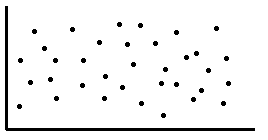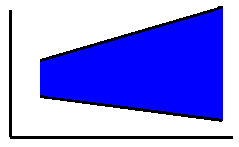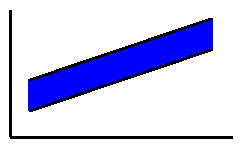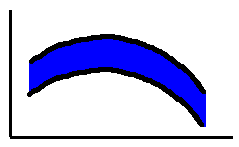Linear Statistical Models: Regression
Regression Diagnostics
Descriptive Statistics and Exploratory Data Analysis
Of course, any data analysis would begin with descriptive statistics and exploratory data analysis.
Included in these analyses would be distribution plots (histograms, stem plots, or kdensity plots).
Plot Dependent Variable vs Predicted Values
One visual check of the goodness-of-fit of the model is to plot the values of
the dependent variable versus the predicted values. When there is perfect
prediction the plot will be a diagonal line.
Residual Analysis
Residuals are the difference between the observed score and the predicted score.

Residuals come in three varieties:
- Raw Residuals: The difference between the raw observed score and the predicted score,
as given in the formula above. Often denoted e or resid.
- Standardized Residuals: These are the raw residuals divided by the standard error of estimate.
Can be denoted rstan or zresid.
- Studentized Residuals: These are raw residuals divided by the standard error of the
residual with that case deleted. These are sometimes called studentized deleted residuals
or studentized jackknifed residuals. Can be denoted rstu.
Outliers
Outliers are cases with large residuals.
- Look for studentized residuals greater than 2.5 in absolute value but don't become
overly alarmed until residuals are greater than 3 or 4.
- Indicates a peculiarity -- data point is not typical of the rest of the data.
- These points should be examined carefully to try to find out why they are there. Perhaps there
was an error in data entry or subjects did not understand instructions, etc.
- It is possible that observations with large residuals may have little
effect on the estimation of b.
- What to do?
- Automatic rejection -- not wise.
- Possible data entry error -- correct error or delete case.
- May be a "real" data point.
Plotting Residuals
- Plot shape of residuals (histogram, kdensity, normal probability).
- Plot of residuals by case (index plot).
- Plot of residuals in time sequence (if applicable).
- Plot of residual vs predicted, aka, residual vs fitted.
- Plot of residual vs each predictor variable.
In General: Residual Plots
- You should get the impression of a horizontal band with points that
vary at random.
- There should be no relation between residuals and predicted (fitted) score.
The picture should look something like this-

DV vs Predictors
- Plot DV vs IVs to check on linearity and association.
Overall Plot of Residuals
- Histogram
- Stem plot
- Normal probability plot
Index Plot -- Plot of Residuals by Case
- If sample is too large, list only cases with residuals greater than ±2.0.
Time Sequence Plot
- You should get impression of a horizontal band with points that vary at random.
1. Watch out for situations in which variance increases with time; try
Weighted Least Squares (W.L.S.)

2. This pattern could indicate that a linear term is missing from the model.

3. This pattern could indicate that both a linear and a quadratic term in time
are missing from the model.

Plot Residuals versus Predicted (Fitted) Scores
- You should get the impression of a horizontal band with points that vary at random.
- There should be no relation between residuals and predicted scores.
- Square root of the absolute value of the residuals vesus fitted is good for
checking for heterogeneity of vaiance.
1. Watch out for situations in which variance is not constant as assumed (may need W.L.S. or
a transformation of Y).

2. This pattern could indicate that a variable is missing from the model
(Also caused by wrongly omitting intercept term in model).

3. An additional term is needed in the model, the square of a variable or an interaction
(again maybe transformation of Y).

Residual Plot versus Predictors
- You should get the impression of a horizontal band with points that vary at random.
- There should be no relation between residuals and IVs.
- Take care in inferring heteogeneity.
1. May need W.L.S. or a transformation of Y.

2. Perhaps errors in calculation?.

3. Need an additional term in X (X2) or transformation of Y..

Leverage
- An observation can be an outlier in another way besides having Y and Y' be far apart. The
independent variable, x, can be far from the center of mass of the other x's.
- Leverage is a measure of how far an independent variable, X, deviates from its mean, Xbar.
- These points can have a large effect on the estimation of b.
- Such points are said to have high leverage.
Influence
- The fact that certain observations have greater influence on regression estimates than other.
- According to Belsley, Kuh & Welsch (1980), an infulential observations
is "one which, either individually or together with several other observations,
has demonstrably larger impact on the calculated values of various estimates
(coefficients, standard errors, t-values, etc.) than is the case for most of
the other observations."
- Consider influence to be the product of leverage and outlierness.
Some Measures of Leverage and Influence
- Leverage (h) -- Sometimes called hat because it uses the diagonal elements of the hat matrix.
- Cook's distance (d) -- Combines information about both residuals and leverage.
- DFBETA -- Measures influence by comparing the b with the case included and excluded. A separate
dfbeta can be computed for each predictor variable.
Values to Watch Out For
| Measure | Value |
|---|
| leverage (h) | > (2k + 2)/n |
|---|
| rstu | > 2.5 |
|---|
| cooksd (d) | > 4/n |
|---|
| |dfbeta| | > 2/sqrt(n) |
|---|
Other Diagnostic Tests
Test for model specification error, sometimes called linktest. Performed by regressing
the residuals and residuals squared against the dependent variable.
regress gpa grev greq
Source | SS df MS Number of obs = 30
---------+------------------------------ F( 2, 27) = 12.73
Model | 5.06332584 2 2.53166292 Prob > F = 0.0001
Residual | 5.37134081 27 .198938548 R-squared = 0.4852
---------+------------------------------ Adj R-squared = 0.4471
Total | 10.4346666 29 .359816091 Root MSE = .44603
------------------------------------------------------------------------------
gpa | Coef. Std. Err. t P>|t| [95% Conf. Interval]
---------+--------------------------------------------------------------------
grev | .0027326 .0011288 2.421 0.022 .0004166 .0050487
greq | .0053559 .0019278 2.778 0.010 .0014003 .0093114
_cons | -1.286698 .9765207 -1.318 0.199 -3.290353 .7169566
------------------------------------------------------------------------------
Link test looks for one type of specification error.
linktest
Source | SS df MS Number of obs = 30
---------+------------------------------ F( 2, 27) = 13.50
Model | 5.21793375 2 2.60896687 Prob > F = 0.0001
Residual | 5.2167329 27 .193212329 R-squared = 0.5001
---------+------------------------------ Adj R-squared = 0.4630
Total | 10.4346666 29 .359816091 Root MSE = .43956
------------------------------------------------------------------------------
gpa | Coef. Std. Err. t P>|t| [95% Conf. Interval]
---------+--------------------------------------------------------------------
_hat | -2.744288 4.190284 -0.655 0.518 -11.34204 5.853464
_hatsq | .5622472 .6285344 0.895 0.379 -.7273988 1.851893
_cons | 6.13873 6.89339 0.891 0.381 -8.005337 20.2828
------------------------------------------------------------------------------
Omitted variable test. Looks for omitted variables by including Y'2, Y'3
and Y'4 in the original model.
ovtest
Ramsey RESET test using powers of the fitted values of gpa
Ho: model has no omitted variables
F(3, 24) = 1.20
Prob > F = 0.3307
Heterogeneity of variance test. Looks for heterogeneity by modeling the variance as a
function of the predicted values.
hettest
Cook-Weisberg test for heteroscedasticity using fitted values of gpa
Ho: Constant variance
chi2(1) = 0.03
Prob > chi2 = 0.8686
Another heterogeneity of variance test. Preferred by some over the Cook-Weisberg test above.
whitetst /* Downloaded from Stata (STB 55, sg137) via the Internet */
White's general test statistic : 10.10781 Chi-sq( 5) P-value = .0722
Diagnostic Plots
- dependent variable versus predicted
- studentized residual versus fitted
- studentized residual versus predictors
- leverage versus residual squared plot (lvr2plot)
- partial-regression residual plot (avplot)
Stata Commands
linktest
ovtest
hettest
whitetst
predict p
predict rstu, rstu
predict h, leverage
predict d, cooksd
dfbeta
Stata Regression Diagnostic Plots
scatter dv p, jitter(2)
rvfplot, yline(0)
rvpplot indepvar, yline(0)
rvfplot2, rstu yline(-2.5 2.5)
rvpplot2 indepvar, rstu yline(-2.5 2.5)
lvr2plot, mlabel(label)
avplot indepvar
Linear Statistical Models Course
Phil Ender, 15Jun98











